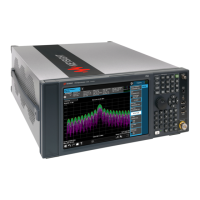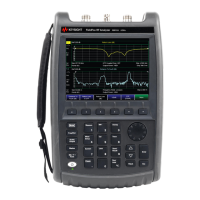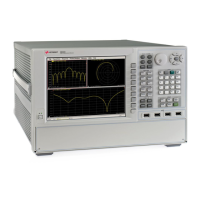N9030B PXA Signal Analyzer Service Guide 251
LO Synthesizer/Reference Troubleshooting
A14 LO Synthesizer Theory of Operation
A14 LO Synthesizer Theory of Operation
The LO Synthesizer can be operated in either dual-loop or single-loop modes.
The dual-loop mode provides lower phase noise but slower tuning speed. The
single-loop mode provides for fast tuning. The dual-loop mode is used for
narrower spans, where phase noise impacts are the greatest, while single-loop
mode is used in the wider spans, where tuning speed is most important.
The analyzer automatically chooses dual-loop mode for spans less than or
equal to 10 MHz. This is the “customer span”, that is, the span annotated on
the screen and visible to the customer. The LO span, which is the span to which
the LO hardware is actually set, will be the customer span divided by N, the
harmonic mixing number. The single-loop mode is automatically selected for
customer spans wider than 10 MHz.
Single Loop Operation
In single-loop mode, the 100 MHz LO Synth reference signal from A16 is
divided by two and the resulting 50 MHz signal is used as the reference input
to the main loop phase/frequency detector. The 1st LO from A13A1J5, Synth
Out, comes into A14J20 and its power is split two ways; one of the splitter
outputs is used for dual-loop mode and the other output is used for
single-loop mode.
In single-loop mode, the 1st LO signal is divided by two, yielding a range of 1.9
to 4.36 GHz and this divided signal is then fed to the fractional-N divider. The
output of the fractional-N divider feeds the other input to the main loop
phase/frequency detector. The output of the phase/frequency detector feeds
the loop integrator which then drives the YTO Main and FM Coil Drivers.
There are also two types of single-loop modes; single-loop narrowband and
single-loop wideband. The single-loop narrowband mode provides lower phase
noise at offsets less than approximately 20 kHz.
Dual Loop Operation
In dual-loop mode, both the 100 MHz LO Synth and 4800 MHz 1st LO
Reference signals are used. The 4800 MHz reference goes into a power splitter
and one splitter output drives the fractional-N divider. The other output is used
to drive a mixer in the Offset Loop synthesizer. The 100 MHz reference is split
and one output used to drive a sampler in the Offset Loop synthesizer and the
other output is divided by either 3 or 6 to yield a 16.6 or 33.3 MHz reference for
the offset loop synthesizer.
The offset loop synthesizer is used to create a signal that is typically 33 to 55
MHz offset from the desired 1st LO frequency. To avoid generating synthesis
related spurs, sometimes the offset is from 78 to 88 MHz. The offset loop
Refer to Chapter 13, “Block Diagrams”.

